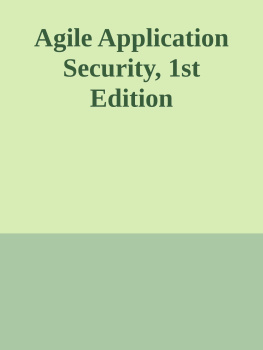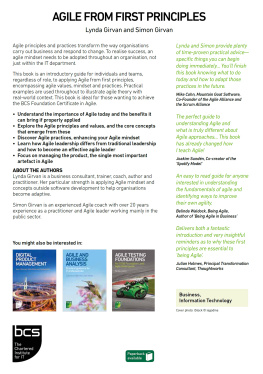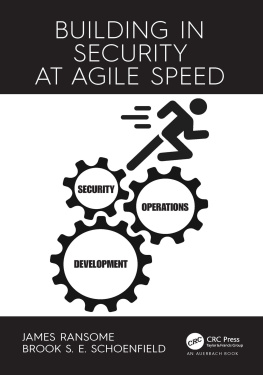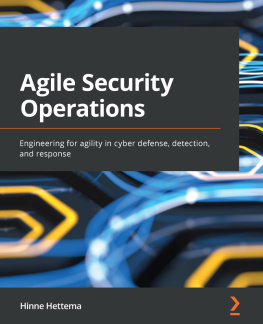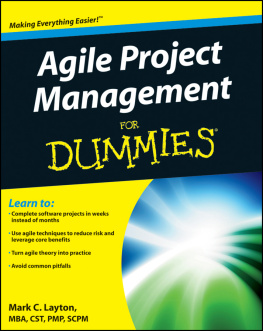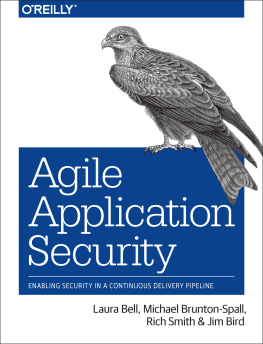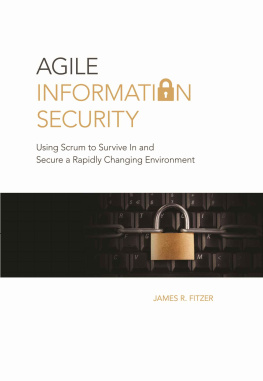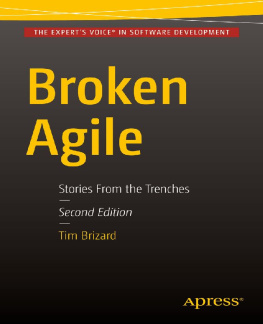Agile Application Security
by Laura Bell , Michael Brunton-Spall , Rich Smith , and Jim Bird
Copyright 2016 Laura Bell, Rich Smith and Michael Brunton-Spall. All rights reserved.
Printed in the United States of America.
Published by OReilly Media, Inc. , 1005 Gravenstein Highway North, Sebastopol, CA 95472.
OReilly books may be purchased for educational, business, or sales promotional use. Online editions are also available for most titles ( http://safaribooksonline.com ). For more information, contact our corporate/institutional sales department: 800-998-9938 or corporate@oreilly.com .
- Editor: Courtney Allen
- Production Editor: FILL IN PRODUCTION EDITOR
- Copyeditor: FILL IN COPYEDITOR
- Proofreader: FILL IN PROOFREADER
- Indexer: FILL IN INDEXER
- Interior Designer: David Futato
- Cover Designer: Karen Montgomery
- Illustrator: Rebecca Demarest
- January -4712: First Edition
Revision History for the First Edition
- 2016-11-15: First Early Release
- 2016-12-01: Second Early Release
- 2017-03-16: Third Early Release
- 2017-06-01: Fourth Early Release
See http://oreilly.com/catalog/errata.csp?isbn=9781491939024 for release details.
The OReilly logo is a registered trademark of OReilly Media, Inc. Agile Application Security, the cover image, and related trade dress are trademarks of OReilly Media, Inc.
While the publisher and the author(s) have used good faith efforts to ensure that the information and instructions contained in this work are accurate, the publisher and the author(s) disclaim all responsibility for errors or omissions, including without limitation responsibility for damages resulting from the use of or reliance on this work. Use of the information and instructions contained in this work is at your own risk. If any code samples or other technology this work contains or describes is subject to open source licenses or the intellectual property rights of others, it is your responsibility to ensure that your use thereof complies with such licenses and/or rights.
978-1-491-93902-4
[FILL IN]
Preface
Software is eating the world. Developers are the new kingmakers. The internet of things means there will be a computer in every light bulb.
These statements indicate the growing dominance of software development, to the point where most people in the world will never be further than a meter away from a computer, and we will expect much of our life to interact with computer-assisted objects and environments all the time.
But this world comes with some dangers. In the old world of computing, security was often only considered in earnest for banking and government style systems. But the rise of ubiquitous computing means a rise in the value that can be realised from the abuse of systems, this increases incentives for misuse, which in turn increases the risks systems face.
Agile software development techniques are becoming rapidly adopted in most organisations, by being responsive to change and dramatically lowering the cost of development, they provide a standard that we expect will continue to grow until the majority of software is built in an agile manner.
However security and agile have not historically been great bedfellows.
Security professionals have had their hands full with the aforementioned government, e-commerce and banking systems, trying to architect, test and secure those systems all in the face of constantly evolving set of threats. Furthermore, what is often seen as the most fun and exciting work in security, the things that get covered on the tech blogs and the nightly news, is currently done by teams of professional hackers focusing on vulnerability research, exploit development, and stunt hacks.
You can probably name a few recent branded vulnerabilities like Heartbleed, Logjam, Shellshock (or heaven forbid even recognise their logos.), or recognise the teams of researchers who have achieved a jailbreak on the latest iPhones and android devices. But when was the last time a new defensive measure or methodology had a cool media friendly name, or you picked up the name of a defender and builder?
Security professionals are lagging behind in their understanding and experience of agile development, and that creates a gap that is scary for our industry.
Equally, agile teams have rejected and thrown off the shackles of the past. No more requirements documents, no more system modeling, no more traditional waterfall hand offs. The problem with this is that agile teams have thrown the baby out with the bathwater. Those practices, while sometimes slow and inflexible, have demonstrated value over the years. They were done for a reason, and agile teams in rejecting them can easily forget and dismiss their value.
This means that agile teams rarely consider security as much as needed. Some of the agile practices make a system more secure, but that is often a beneficial side effect rather than the purpose. Very few agile teams have an understanding of the threats that face their system, they dont understand the risks they are taking, they dont track or do anything to control those risks, and they often have a poor understanding of who it even is that are attacking their creations.
Who Should Read This Book
We dont know if you are an agile team leader or developer who is curious or wants to know more about security. Maybe you are a security practitioner who has just found an entire development team you didnt know existed and you want to know more.
This book was written with 3 main audiences in mind:
The Agile Practitioner
You live, breathe and do Agile. You know your Scrum from your Kaizen, your test-driven-development from your feedback loop. Whether you are a Scrum Master, developer, tester, agile coach or just a practitioner, you understand the agile practices and values.
This book should help you understand what security is about, what threats exist and the language that security practitioners use to describe what is going on. Well help you understand how we model threats, measure risks, build software with security in mind, operate software securely and understand the operational security issues that come with running a service.
The Security Practitioner
Whether you are a risk manager, an information assurance specialist, or a security operations analyst, you understand security. You are probably careful how you use online services, you think about threats and risks and mitigations all of the time, and you may have even found new vulnerabilities and exploited them yourself.
This book should help you understand how software is actually developed in agile teams, and what on earth those teams are talking about when they talk about sprints and stories. You will learn to see the patterns in the chaos, and that should help you interact and influence the team. This book should show you where you can intervene or contribute that is most valuable to an agile team, and has the best effect.
The Agile Security Practitioner
From risk to sprints, you know it all. Whether you are a tool builder who is trying to help teams do security well, or a consultant who advises teams, this book is also for you. The main thing to get out of this book is to understand what the authors consider to be the growing measure of good practice. This book should help you be aware of others in your field, of the ideas and thoughts and concepts that we are seeing pop up in organisations dealing with this problem. It should give you a good broad understanding of the field and an idea for what to research or learn about next.

